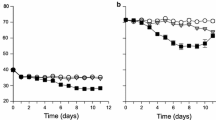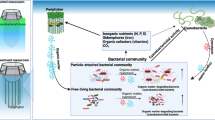Abstract
Anabaena species are commonly colonized by bacteria, especially during N2-fixing blooms. Generally these associations do not represent bacterial attack on algal hosts. Instead, the algal N2-fixing capabilities are increased in the presence of the bacteria. Possible mechanisms promoting the mutual growth of algae and attached bacteria were investigated by observing specific sites of bacterial attachment, by noting reduced microzones created by the bacteria, and by locating sites of bacterial uptake of organics representative of algal excretion products.
Attached bacteria show preference for typical algal excretion products and their growth is enhanced by such products. In return, enhancement of algal nitrogenase activity occurs when bacteria create O2-consuming microzones around the nitrogenase-bearing heterocysts.
Similar content being viewed by others
References
Carpenter, E.J., and C.C. Price: MarineOscillatoria (Trichodesmium): Explanation for aerobic nitrogen fixation without heterocysts. Science191, 1278–1280 (1976)
Donze, J., J. Haveman, and P. Schiereck: Absence of photosystem 1 in heterocysts of the blue-green algaAnabaena. Biochim. Biophys. Acta256, 157–161 (1971)
Drawert, G., and I. Tischer: Über Redox-Vorgänge bei Cyanophycean unter besonder Berucksichtigung der heterocysten. Naturwissenschaften43, 132–145 (1956)
Fay, P., W.D.P. Stewart, A.E. Walsby, and G.E. Fogg: Is the heterocyst the site of nitrogen fixation in blue-green algae? Nature220, 810–812 (1968)
Fay, P., and S.A. Kulisooriya: Tetrazolium reduction and nitrogenase activity in heterocystous blue-green algae. Arch. Microbiol.87, 341–352 (1971)
Fogg, G.E.: The production of extracellular nitrogenous substances by a blue-green algae. Proc. R. Soc. Biol.139, 371–397 (1952)
Fogg, G.E., and J. Pattnaik: The release of extracellular nitrogenous products byWestiellopsis prolifica. Phykos5, 58–67 (1966)
Holm-Hansen, O.: ATP levels in algae as influenced by environmental conditions. Plant Cell Physiol. (Tokyo)11, 689–700 (1970)
Holm-Hansen, O., and C.R. Booth: The measurement of adenosine triphosphate in the ocean and its ecological significance. Limnol. Oceanogr.11, 510–519 (1966)
Lange, W.: Effect of carbohydrates on the symbiotic growth of the planktonic blue-green algae with bacteria. Nature215, 1277–1278 (1967)
Mullin, M.M., P.R. Sloan, and R.W. Eppley: Relationship between carbon content, cell volume, and area in phytoplankton. Limnol. Oceanogr.10, 307–311 (1966)
Paerl, H.W.: Bacterial uptake of dissolved organic matter in relation to detrital aggregation in marine and freshwater systems. Limnol. Oceanogr.19, 966–972 (1974)
Paerl, H.W.: Specific associations of the blue-green algaeAnabaena andAphanizomenon with bacteria in freshwater blooms. J. Phycol.12, 431–435 (1976)
Paerl, H.W., and S.L. Shimp: Preparation of filtered plankton and detritus with scanning electron microscopy. Limnol. Oceanogr.18, 802–805 (1973)
Paerl, H.W., and N.J. Williams: The relation between adenosine triphosphate and microbial biomass in diverse aquatic ecosystems. Int. Rev. Ges. Hydrobiol.61, 659–664 (1976)
Sirenko, L.A., N.M. Stetsenko, V.V. Avendarchuk, and M.I. Kuz'menko: Role of oxygen conditions in the vital activity of certain blue-green algae. Microbiology37, 199–202 (1968)
Sorokin, Y.I.: On the trophic role of chemosynthesis and bacterial biosynthesis in water bodies. Mem. Ist. Ital. Idrobiol. Suppl.18, 189–198 (1965)
Tel Orr, E., and W.D.P. Stewart: Photo synthetic electron transport, ATP synthesis and nitrogenase activity in isolated heterocysts ofAnabaena cylindrica. Biochim. Biophys. Acta423, 189–195 (1976)
Vance, B.D.: Sensitivity ofMicrocystis aeruginosa and other blue-green algae and associated bacteria to selected antibiotics. J. Phycol.2, 125–128 (1966)
Walsby, A.E., and G.E. Fogg: The extracellular products ofAnabaena cylindrica. Br. Phycol. J.10, 339–345 (1975)
Wolk, C.P.: Movement of carbon from vegetative cells to heterocysts inAnabaena cylindrica. J. Bacteriol.96, 2138–2143 (1968)
Author information
Authors and Affiliations
Rights and permissions
About this article
Cite this article
Paerl, H.W. Role of heterotrophic bacteria in promoting N2 fixation byAnabaena in aquatic habitats. Microb Ecol 4, 215–231 (1977). https://doi.org/10.1007/BF02015078
Issue Date:
DOI: https://doi.org/10.1007/BF02015078




